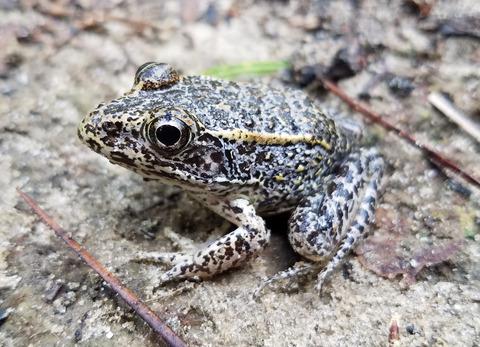当前位置:
X-MOL 学术
›
Anim. Conserv.
›
论文详情
Our official English website, www.x-mol.net, welcomes your
feedback! (Note: you will need to create a separate account there.)
Survival, movements and habitat use of captive‐bred and reintroduced dusky gopher frogs
Animal Conservation ( IF 2.8 ) Pub Date : 2020-05-16 , DOI: 10.1111/acv.12599 E. A. Roznik 1 , S. B. Reichling 1
Animal Conservation ( IF 2.8 ) Pub Date : 2020-05-16 , DOI: 10.1111/acv.12599 E. A. Roznik 1 , S. B. Reichling 1
Affiliation

|
Despite the growing roles of assisted reproduction and captive breeding in reintroductions, we have a limited understanding of the viability of these animals once released. We radiotracked endangered dusky gopher frogs Lithobates sevosus for up to 24 days after they were released into the wild to (1) assess the viability of juvenile frogs produced using artificial fertilization and raised in captivity until four weeks post‐metamorphosis, (2) investigate survival rates, movement patterns, and habitat use and (3) examine whether it is more beneficial to release frogs at the pond edge or into burrows in the uplands. Released frogs had a relatively high survival rate (76% overall, with mortality ceasing after 14 days) and behaved as expected, moving fairly long distances (up to 153 m daily and 426 m total) and locating suitable shelters, including burrows and stump holes. Frogs that sheltered underground had a 22% higher survival rate than frogs that did not, highlighting the importance of these habitat features. Compared to frogs released into burrows, frogs released at the pond had a 33% lower survival rate, spent less time underground and moved farther and more often, likely while searching for shelter. Frogs selected habitat characteristics that are associated with effects of fire, including an open canopy and abundant ground vegetation. Our study demonstrates that juvenile dusky gopher frogs successfully transitioned to their natural habitat, and that any effects of artificial fertilization or captivity on juvenile viability appear to be minimal. Releasing frogs into areas with abundant underground refuges and using frequent prescribed fire to maintain the habitat should benefit dusky gopher frog populations and improve the success of reintroductions.
中文翻译:

圈养和重新引入的灰鼠蛙的生存,运动和栖息地利用
尽管辅助繁殖和圈养繁殖在重新引入中起着越来越大的作用,但我们对这些动物一旦被释放的生存能力了解有限。我们用无线电跟踪了濒临灭绝的昏暗地鼠蛙Lithobates sevosus它们被释放到野外后长达24天,以(1)评估通过人工施肥生产并圈养的幼蛙的生存能力,直到变态后四周;(2)研究成活率,活动方式和栖息地的使用(3)检查在池塘边缘或高地的洞穴中释放青蛙是否更有益。释放的青蛙具有相对较高的存活率(总体为76%,14天后死亡率会降低),并且表现出预期,移动距离较长(每天最多153 m,总共426 m),并找到合适的避难所,包括洞穴和树桩洞。 。躲藏在地下的青蛙的存活率比未躲藏的青蛙高22%,突显了这些栖息地特征的重要性。与被释放到洞穴中的青蛙相比,在池塘中释放的青蛙的成活率降低了33%,在地下停留的时间更少,并且移动的距离越来越远,甚至更多,这可能是在寻找庇护所时。青蛙选择了与火势相关的栖息地特征,包括开放的树冠和丰富的地面植被。我们的研究表明,幼年灰蒙蒙地蛙已成功过渡到其自然栖息地,而且人工受精或人工饲养对幼年生存力的任何影响似乎都很小。将青蛙释放到地下避难所丰富的地区,并经常使用指定的火力维持生境,应使昏暗的地鼠蛙种群受益,并提高重新引入的成功率。青蛙选择了与火势相关的栖息地特征,包括开放的树冠和丰富的地面植被。我们的研究表明,幼年灰蒙蒙地蛙已成功过渡到其自然栖息地,而且人工受精或人工饲养对幼年生存力的任何影响似乎都很小。将青蛙释放到地下避难所丰富的地区,并经常使用指定的火力维持生境,应使昏暗的地鼠蛙种群受益,并提高重新引入的成功率。青蛙选择了与火势相关的栖息地特征,包括开放的树冠和丰富的地面植被。我们的研究表明,幼年灰蒙蒙地蛙已成功过渡到其自然栖息地,而且人工受精或人工饲养对幼年生存力的任何影响似乎都很小。将青蛙释放到地下避难所丰富的地区,并经常使用指定的火力维持生境,将使昏暗的地鼠蛙种群受益,并提高重新引入的成功率。人工受精或人工饲养对幼年生存力的影响看来很小。将青蛙释放到地下避难所丰富的地区,并经常使用指定的火力维持生境,应使昏暗的地鼠蛙种群受益,并提高重新引入的成功率。人工受精或人工饲养对幼年生存力的影响看来很小。将青蛙释放到地下避难所丰富的地区,并经常使用指定的火力维持生境,应使昏暗的地鼠蛙种群受益,并提高重新引入的成功率。
更新日期:2020-05-16
中文翻译:

圈养和重新引入的灰鼠蛙的生存,运动和栖息地利用
尽管辅助繁殖和圈养繁殖在重新引入中起着越来越大的作用,但我们对这些动物一旦被释放的生存能力了解有限。我们用无线电跟踪了濒临灭绝的昏暗地鼠蛙Lithobates sevosus它们被释放到野外后长达24天,以(1)评估通过人工施肥生产并圈养的幼蛙的生存能力,直到变态后四周;(2)研究成活率,活动方式和栖息地的使用(3)检查在池塘边缘或高地的洞穴中释放青蛙是否更有益。释放的青蛙具有相对较高的存活率(总体为76%,14天后死亡率会降低),并且表现出预期,移动距离较长(每天最多153 m,总共426 m),并找到合适的避难所,包括洞穴和树桩洞。 。躲藏在地下的青蛙的存活率比未躲藏的青蛙高22%,突显了这些栖息地特征的重要性。与被释放到洞穴中的青蛙相比,在池塘中释放的青蛙的成活率降低了33%,在地下停留的时间更少,并且移动的距离越来越远,甚至更多,这可能是在寻找庇护所时。青蛙选择了与火势相关的栖息地特征,包括开放的树冠和丰富的地面植被。我们的研究表明,幼年灰蒙蒙地蛙已成功过渡到其自然栖息地,而且人工受精或人工饲养对幼年生存力的任何影响似乎都很小。将青蛙释放到地下避难所丰富的地区,并经常使用指定的火力维持生境,应使昏暗的地鼠蛙种群受益,并提高重新引入的成功率。青蛙选择了与火势相关的栖息地特征,包括开放的树冠和丰富的地面植被。我们的研究表明,幼年灰蒙蒙地蛙已成功过渡到其自然栖息地,而且人工受精或人工饲养对幼年生存力的任何影响似乎都很小。将青蛙释放到地下避难所丰富的地区,并经常使用指定的火力维持生境,应使昏暗的地鼠蛙种群受益,并提高重新引入的成功率。青蛙选择了与火势相关的栖息地特征,包括开放的树冠和丰富的地面植被。我们的研究表明,幼年灰蒙蒙地蛙已成功过渡到其自然栖息地,而且人工受精或人工饲养对幼年生存力的任何影响似乎都很小。将青蛙释放到地下避难所丰富的地区,并经常使用指定的火力维持生境,将使昏暗的地鼠蛙种群受益,并提高重新引入的成功率。人工受精或人工饲养对幼年生存力的影响看来很小。将青蛙释放到地下避难所丰富的地区,并经常使用指定的火力维持生境,应使昏暗的地鼠蛙种群受益,并提高重新引入的成功率。人工受精或人工饲养对幼年生存力的影响看来很小。将青蛙释放到地下避难所丰富的地区,并经常使用指定的火力维持生境,应使昏暗的地鼠蛙种群受益,并提高重新引入的成功率。











































 京公网安备 11010802027423号
京公网安备 11010802027423号